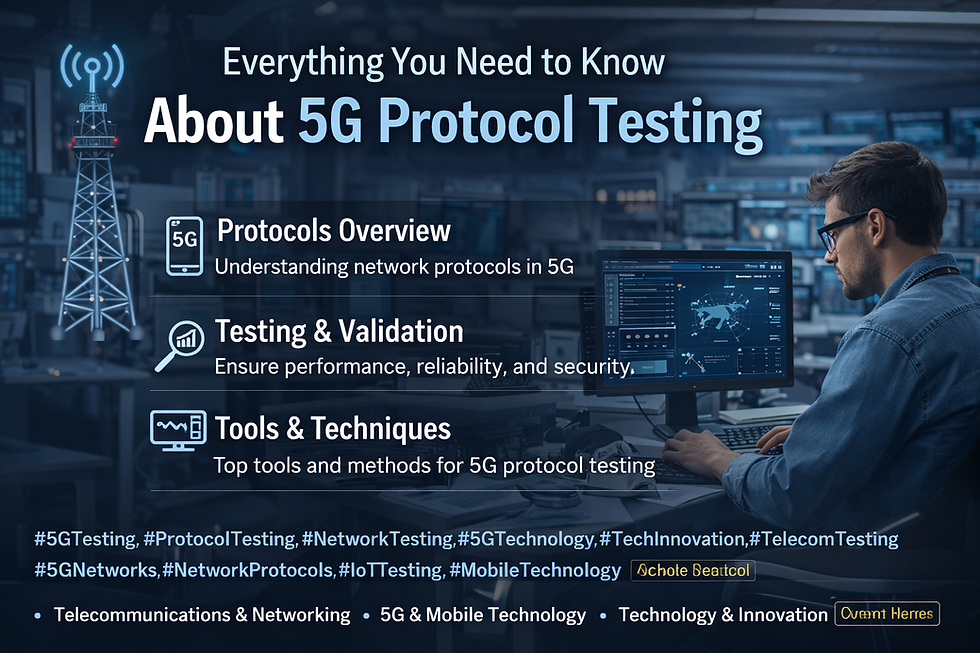The Evolution of Network Slicing with 5G Telco Cloud in 2024
- Sameer Krishn
- Jun 18, 2024
- 4 min read
Updated: Jun 27, 2024

Table of Contents
Introduction
Understanding Network Slicing
Benefits of Network Slicing in 5G Telco Cloud
Implementation Challenges
Future Prospects of Network Slicing
Conclusion
Introduction
As the telecommunications industry continues to evolve, the concept of network slicing has emerged as a revolutionary approach to network management. With the advent of 5G Telco Cloud, network slicing promises to provide customized and efficient network services to meet the diverse needs of various industries. This blog explores the evolution of network slicing, its benefits, implementation challenges, and future prospects in 2024.
Understanding Network Slicing
Network slicing is a technique that allows multiple virtual networks to be created on a shared physical infrastructure. Each network slice is customized to meet specific requirements of different use cases, ensuring optimal performance and resource allocation.
1. Concept of Network Slicing
Network slicing leverages virtualization technologies to divide a single physical network into multiple isolated virtual networks. Each slice operates independently and is tailored to specific applications, such as enhanced mobile broadband (eMBB), ultra-reliable low-latency communications (URLLC), and massive machine-type communications (mMTC). This enables telecom operators to offer differentiated services to various industries.
2. Role of 5G Telco Cloud
The deployment of 5G Telco Cloud plays a crucial role in the implementation of network slicing. The cloud-native architecture of 5G networks allows for the dynamic creation, modification, and management of network slices. This flexibility is essential for meeting the diverse and ever-changing demands of different industries.
3. Standards and Protocols
Network slicing is governed by standards and protocols established by organizations such as the 3rd Generation Partnership Project (3GPP) and the European Telecommunications Standards Institute (ETSI). These standards ensure interoperability and seamless integration of network slices across different networks and devices.
Benefits of Network Slicing in 5G Telco Cloud
Network slicing offers numerous benefits, making it a key enabler for the success of 5G Telco Cloud. These benefits include enhanced network efficiency, customized services, and improved resource utilization.
1. Enhanced Network Efficiency
Network slicing optimizes the use of network resources by allocating them based on the specific requirements of each slice. This results in improved network efficiency and performance. For instance, a slice dedicated to eMBB can be optimized for high data rates, while a slice for URLLC can be tailored for low latency and high reliability.
2. Customized Services
With network slicing, telecom operators can offer customized services to meet the unique needs of different industries. For example, a slice can be created for smart grid applications in the energy sector, ensuring reliable and secure communication for critical infrastructure. Similarly, a slice for autonomous vehicles can provide ultra-low latency and high bandwidth for real-time data processing.
3. Improved Resource Utilization
Network slicing allows for more efficient utilization of network resources by dynamically allocating them based on demand. This reduces wastage and ensures that resources are available where they are needed the most. As a result, telecom operators can achieve cost savings and maximize the return on investment in 5G infrastructure.
Implementation Challenges
Despite its numerous benefits, the implementation of network slicing with 5G Telco Cloud presents several challenges. These challenges must be addressed to fully realize the potential of network slicing.
1. Complexity of Network Management
The management of multiple network slices on a shared infrastructure introduces complexity in network operations. Telecom operators need advanced tools and technologies to monitor, manage, and optimize each slice effectively. This requires significant investment in network management solutions and skilled personnel.
2. Interoperability Issues
Ensuring interoperability between different network slices and across various devices and networks is a major challenge. Telecom operators must adhere to industry standards and protocols to achieve seamless integration. However, the lack of uniformity in standards can lead to compatibility issues and hinder the widespread adoption of network slicing.
3. Security Concerns
Network slicing introduces additional security risks as each slice operates independently and may have different security requirements. Telecom operators must implement robust security measures to protect each slice from cyber threats and ensure data privacy. This includes encryption, authentication, and regular security audits.
Future Prospects of Network Slicing
The future of network slicing with 5G Telco Cloud looks promising, with significant advancements expected in the coming years. These advancements will drive innovation and open up new opportunities across various sectors.
1. Integration with AI and ML
The integration of artificial intelligence (AI) and machine learning (ML) with network slicing is expected to enhance network management and optimization. AI and ML algorithms can analyze network data in real-time to predict demand, allocate resources dynamically, and identify potential issues before they impact service quality.
2. Expansion of Use Cases
As network slicing technology matures, its application will expand to new use cases beyond traditional telecommunications. Industries such as healthcare, agriculture, and manufacturing will leverage network slicing to deploy innovative solutions that require tailored network services. For example, in healthcare, network slicing can enable remote surgery and telemedicine applications with high reliability and low latency.
3. Global Standardization
The development of global standards and protocols for network slicing will drive its widespread adoption. Standardization will ensure interoperability and seamless integration across different networks and devices. Organizations such as 3GPP and ETSI will continue to play a crucial role in defining these standards and promoting their implementation worldwide.
Conclusion
Network slicing with 5G Telco Cloud is poised to revolutionize the telecommunications industry by providing customized and efficient network services. While there are challenges to overcome, the benefits of enhanced network efficiency, customized services, and improved resource utilization make network slicing a key enabler for the success of 5G. The future of network slicing looks promising, with advancements in AI and ML, expansion of use cases, and global standardization driving its growth.
Internal URLs:
Apeksha Telecom's training programs: https://www.apekshatelecom.com/training
Apeksha Telecom's placement assistance: https://www.apekshatelecom.com/placement-assistance
External URLs:
Telecom Gurukul: https://www.telecomgurukul.com
Reference URLs:
"The Evolution of Network Slicing with 5G Telco Cloud" - Apeksha Telecom: https://www.telecomgurukul.com/post/the-evolution-of-network-slicing-with-5g-telco-cloud




Comments